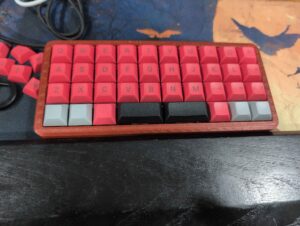 As I have continued my keyboard journey, my keyboards have gotten smaller and smaller. While many people use forty percent keyboards as their daily drivers, there are some who use them for when portability is a must. I am writing this on one of those keyboards.
As I have continued my keyboard journey, my keyboards have gotten smaller and smaller. While many people use forty percent keyboards as their daily drivers, there are some who use them for when portability is a must. I am writing this on one of those keyboards.
The most common way to allow for smaller keyboards would be layers. Layers are second keymaps triggered usually by holding down a key. Your keyboard may have that as a Fn key. I continue to try to tweak my layers on various keyboards, and looking to optimize my typing. But I had not really conceptualized how to use some of the other features that QMK, the most popular open source keyboard firmware, supports.
I recently turned to two other QMK features: Tap Dance and Combos.
- Tap Dance is a feature that allows you to set different keys based on tap, double tap, or hold.
- Combos allow two or more keys to produce a key output
The keyboard above is the Acai PCB in a 3d printed case. I built this from components and typed this post on it. The Acai is a 4×10 ortholinear keyboard. The bottom row is customizable with a variety of different spacebar lengths from a single key to the full width of the board.
I have spent a fair amount of time with 4×12 ortholinear boards, like the popular Planck. The extra two columns allow for modifiers along the sides, depending on how you configure the keys. Modifiers would be things like Ctrl, Enter, Shift, and so on. If you look at the Acai, there is no room to the left and right of the alphas(letters) for that. The only modifiers would have to be places on the bottom row in most configurations.
Until recently, I had solved this mostly with layers. I would press a key and that would remap the other rows. But this meant for some keys, I needed to press a key on the bottom row and one on far from it on the board, which is not always ideal configuration wise.
Scrolling through advice one day, I was reminded of combos. With them, instead of holding a layer key, two keys could produce what I wanted…so I started with their suggestions.
- P and O, occupying the space a backspace key might, when pressed together produce a backspace
- A and S generate a TAB
- Q and W an ESCape
This worked more efficiently for me and I experimented with a few more. With customizable firmware like QMK, or QMK firmware with Vial compiled in, which allows you to play with these things in real time without having to recompile, the limit is memory capacity and your imagination.
For Tap Dance, I have made holding down the T key scroll up, and B down. The challenge for tap dance is when you are typing a word with the same letter in a row, like the word letter. If you don’t retrain yourself, you’ll trigger your secondary key. I recently traded something for a Ploopy Nano, which is a tiny trackball, which has no buttons. With tap dance, I can make a key combination be my mouse, allowing for an even smaller setup.
There are many reasons to try an ortholinear keyboard, or a forty percent keyboard. However, the fact you can can carry around an even smaller keyboard when on the go is not usually one people think about. With these features and a little practice, you can have your own tiny keyboard that suits your needs.
